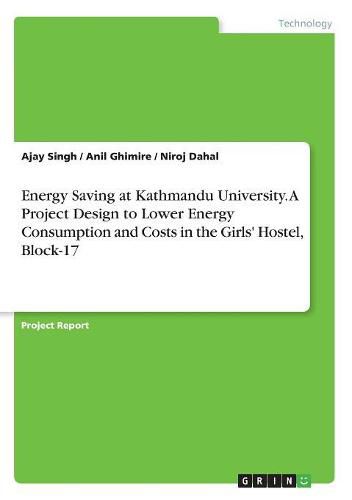Readings Newsletter
Become a Readings Member to make your shopping experience even easier.
Sign in or sign up for free!
You’re not far away from qualifying for FREE standard shipping within Australia
You’ve qualified for FREE standard shipping within Australia
The cart is loading…






Project Report from the year 2016 in the subject Engineering - Power Engineering, grade: 5.00, Kathmandu University, language: English, abstract: This project report draws attention to the energy management process and opportunities in girls’ hostel (Block-17) of Kathmandu University and different energy saving strategies with economic analysis and risks involved. The major energy consumption in the building is the lighting sources and consumes 73kWh/day in average with maximum loading of 8.652 kW. The major lighting sources, which consumes electricity, are Fluorescent Tube Lights (FTLs) and Compact Tube Lights (CFLs) used in building lighting design. The calculated cost of electrical energy by these sources are NRs.22746.30 under certain assumptions. The expected saving opportunities in building are by meeting state-of-the-art in lighting technology achieved by replacement of CFLs and FTLs by LED technology and Boost the building by green energy. The first opportunity save electricity 39kWh/day in average and thus reduction in cost by 53.3%. The second one option goes to green energy but have higher cost of energy. The both saving opportunities have its own financial and environmental risks involved. Two models are therefore developed: i) Replacement of CFLS and FTLs by LED in stages and ii) Solar-Grid Hybrid System. Each of the developed models save energy and cost and both have low environmental and financial risks involved in it.
$9.00 standard shipping within Australia
FREE standard shipping within Australia for orders over $100.00
Express & International shipping calculated at checkout
Project Report from the year 2016 in the subject Engineering - Power Engineering, grade: 5.00, Kathmandu University, language: English, abstract: This project report draws attention to the energy management process and opportunities in girls’ hostel (Block-17) of Kathmandu University and different energy saving strategies with economic analysis and risks involved. The major energy consumption in the building is the lighting sources and consumes 73kWh/day in average with maximum loading of 8.652 kW. The major lighting sources, which consumes electricity, are Fluorescent Tube Lights (FTLs) and Compact Tube Lights (CFLs) used in building lighting design. The calculated cost of electrical energy by these sources are NRs.22746.30 under certain assumptions. The expected saving opportunities in building are by meeting state-of-the-art in lighting technology achieved by replacement of CFLs and FTLs by LED technology and Boost the building by green energy. The first opportunity save electricity 39kWh/day in average and thus reduction in cost by 53.3%. The second one option goes to green energy but have higher cost of energy. The both saving opportunities have its own financial and environmental risks involved. Two models are therefore developed: i) Replacement of CFLS and FTLs by LED in stages and ii) Solar-Grid Hybrid System. Each of the developed models save energy and cost and both have low environmental and financial risks involved in it.